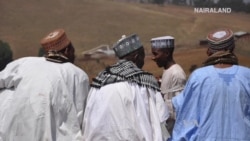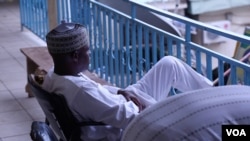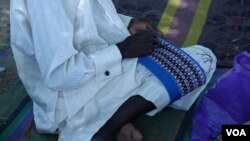It’s known by many names - fila, hula or yaudi. Whatever name you use, it’s still a Bama cap, a distinctive hat made by the Bama people of Nigeria's Borno State.
Prized across West Africa for their intricate embroidery, the hats are now being woven into Nigerian pop culture, worn by young and old, from politicians to music celebrities.
Nigerian rapper Naeto C made a stunning fashion statement when he wore a Bama cap with urban streetwear in the music video for his 2011 hit single 10 over 10.
President Muhammadu Buhari is rarely seen without his Bama cap. Women are also rocking the style, led by creative female music celebrities.
The Bama people have been making their caps for hundreds of years, but not too many people know the full story.
Survivors of terror
“The Bama cap began in Yaudi, that’s the town in the Bama area of Borno state. It was worn by the leaders of the community,” explains Ahmed Isa Ghondi.
Ghondi is a promoter of the Bama cap and has written up to 40 unpublished books on the tradition. But there is also a dark side to the story.
Bama was nearly wiped out by Boko Haram, the violent Islamic extremist group that has left a trail of bloodshed through northeastern Nigeria for years. Those who survived the carnage flocked to Maiduguri. The state capital, Borno's largest city and commercial hub, also has been wracked by Boko Haram's attacks, but it is still safer than Bama.
“They’ll take your wife," Bama native Dunoma Gambo says of Boko Haram. "They’ll take your child and they’ll also force you into joining them.”
Gambo escaped such a fate by fleeing to Maiduguri, where he now is part of a collective of internally displaced Bama people. They kept up their cultural tradition of sewing Bama caps after arriving in the state capital, and the collective has flourished.
Traditional techniques and designs
“I grew up and saw people sewing and that’s how I learned," Gambo says. "You will be practicing and you will make many mistakes, but with time, you will do it right. I’ve now been an expert in it for 12 years.”
Each cap starts with a design template that is sketched by hand, using a ruler and colored markers.
Templates can be bought for less than $10. Once there’s a template, the sewing of the cap's base begins. The white centerpiece on the top goes on last.
Depending on the number of layers in the design, a cap can take anywhere from two to five weeks to sew. Everything is done by hand.
In Maiduguri, the caps sell for about $20. In Abuja, Nigeria's capital, they sell for at least $50, and on up to $180.
The Bama caps are now popular across West Africa.
Caps symbolize national unity
“The caps, they are very strong. That’s why people from different parts of the country buy them," says Sani Mohammed, who traveled from Kaduna state to buy caps for his upcoming wedding.
"The cap brings unity among Nigerians,” Sani Mohammed says. Even though he is not from Bama, he wants to wear a Bama cap on his wedding day.
“Everyone comes here, all the tribes - from Yoruba to Igbo to non-Nigerians,” says 25-year-old Mohammed Fantami. At his fashion shop in Abuja, he says, the Bama caps sell out quickly, in part because they are a symbol of prestige.
“Wearing a cap brings respect," Fantami says. "Between two people, if one is wearing a cap and the other is not, there is a difference. Even if you see a small kid with a cap, you will respect him."
Once the caps arrive from Maiduguri, they are hand-washed and starched. After drying in the sun for at least 12 hours, the caps are pressed with a charcoal iron.
Bama cap promoter Ahmed Isa Ghondi wants to expand the cap-making industry. He drives around, telling people about what makes the caps so special.
“Because of the hand stitching, the fact that it was made by hand,” he says. “You know, the carpets in Uzbekistan are famous because they are hand-stitched. So these caps must also be famous.”
Men from Bama like Dunoma Gambo will continue to sew their traditional caps in Maiduguri. They say Boko Haram fighters may have destroyed their homes in Bama, but they have not destroyed the Bama cap.












